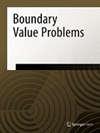三维 st模型的衰减
IF 1.7
4区 数学
Q1 MATHEMATICS
引用次数: 0
摘要
摘要本文考虑三维l本文章由计算机程序翻译,如有差异,请以英文原文为准。
Decay of the 3D Lüst model
Abstract In this paper, we consider the time-decay rate of the strong solution to the Cauchy problem for the three-dimensional Lüst model. In particular, the optimal decay rates of the higher-order spatial derivatives of the solution are obtained. The $\dot{H}^{-s}$ H ˙ − s ( $0\leq s<\frac{3}{2}$ 0 ≤ s < 3 2 ) negative Sobolev norms are shown to be preserved along time evolution and enhance the decay rates.
求助全文
通过发布文献求助,成功后即可免费获取论文全文。
去求助
来源期刊

Boundary Value Problems
数学-数学
自引率
5.90%
发文量
83
审稿时长
3 months
期刊介绍:
The main aim of Boundary Value Problems is to provide a forum to promote, encourage, and bring together various disciplines which use the theory, methods, and applications of boundary value problems. Boundary Value Problems will publish very high quality research articles on boundary value problems for ordinary, functional, difference, elliptic, parabolic, and hyperbolic differential equations. Articles on singular, free, and ill-posed boundary value problems, and other areas of abstract and concrete analysis are welcome. In addition to regular research articles, Boundary Value Problems will publish review articles.
 求助内容:
求助内容: 应助结果提醒方式:
应助结果提醒方式:


